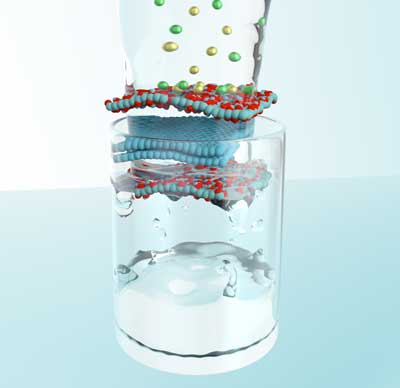Nanofiltration
Nanofiltration is a type of membrane filtration process that is used to separate molecules based on size. It is one of the four membrane technologies that utilize pressure to effect separation of contaminants from water streams but it is more selective in the types of molecules it can filter out. The other three are microfiltration, ultrafiltration and reverse osmosis (RO). All of these technologies utilize semi-permeable membranes that have the ability to reject dissolved and/or suspended solids from a water stream containing these contaminants. As a result, nanofiltration is often used in a variety of applications, including water treatment, food and beverage processing, and the pharmaceutical industry.

One of the main advantages of nanofiltration is its ability to remove dissolved contaminants from water, such as pesticides, herbicides, and pharmaceuticals. It is also effective at removing viruses, bacteria, and other pathogens, making it a critical tool in ensuring the safety of drinking water. In fact, the World Health Organization (WHO) recommends the use of nanofiltration and other membrane filtration processes for the treatment of drinking water (Source: WHO Guidelines for Drinking-water Quality).
In addition to water treatment, nanofiltration is also used in the food and beverage industry to remove unwanted flavors and odors, as well as to concentrate juices and other products. For example, nanofiltration can be used to remove color and off-flavors from fruit juices, resulting in a product with improved quality. Nanofiltration has also been used to clarify and stabilize beer, as well as to remove allergens from peanuts and other nuts.
In the pharmaceutical industry, nanofiltration is used to purify active pharmaceutical ingredients and to remove impurities from drug products. This ensures the safety and effectiveness of the final product. For example, nanofiltration has been used to purify monoclonal antibodies, which are used in the treatment of cancer and other diseases.
Nanofiltration membranes are made of a variety of materials, including nanomaterials such as graphene, nanofibers and carbon nanotubes, cellulose acetate, polysulfone, and polyamide. These membranes have a pore size in the nanometer range (down to 1 nanometer), which allows them to selectively filter out molecules based on size and charge. The choice of membrane material and pore size depends on the specific application and the types of molecules that need to be separated.
The efficiency of a nanofiltration system depends on a number of factors, including the type of membrane used, the pressure of the feed water, and the pH and temperature of the water. To ensure optimal performance, it is important to properly design and maintain a nanofiltration system. This includes regularly cleaning and replacing the membrane, as well as monitoring the system for any signs of fouling or other issues.
One of the challenges of nanofiltration is that it can be energy-intensive, as it requires high pressure to force the water through the membrane. However, advances in membrane technology and system design have led to the development of more energy-efficient nanofiltration systems. For example, the use of spiral-wound membranes and energy recovery devices can significantly reduce the energy consumption of a nanofiltration system.
In conclusion, nanofiltration is a versatile and effective filtration process that is widely used in a variety of industries. It is a critical tool in ensuring the safety and purity of water and other products, and its importance is likely to continue to grow in the coming years.
10 Examples of nanofiltration
Water treatment: Nanofiltration can be used to remove contaminants, such as bacteria, viruses, and organic molecules, from water. It is often used in conjunction with other water treatment methods, such as reverse osmosis, to provide a high-quality, safe drinking water supply.
Desalination: Nanofiltration can be used to remove salt and other minerals from seawater, making it suitable for irrigation and other non-potable uses. Especially purification membranes that can easily clean themselves when fouled could make pressure-driven membrane filtration systems used to treat and desalinate water more energy-efficient.
Food and beverage processing: Nanofiltration can be used to purify and concentrate fruit juices, milk, and other food and beverage products, as well as to remove unwanted flavors and aromas. One example is a graphene-based membrane with precise molecular sieving and ultrafast solvent permeation to turn whisky clear.
Pharmaceutical manufacturing: Nanofiltration can be used to purify and concentrate active ingredients in pharmaceutical products, as well as to remove impurities and contaminants.
Industrial wastewater treatment: Nanofiltration can be used to remove contaminants and pollutants from industrial wastewater, allowing it to be safely discharged or reused. For instance, researchers have demonstrated a novel approach by designing an innovative composite material, consisting of a nanoporous, ultrathin covalent organic framework (COF) anchored on graphene, that is highly efficient at filtering organic pollutants from water.
Oil and gas production: Nanofiltration can be used to remove impurities and contaminants from crude oil and natural gas, improving their quality and making them more valuable.
Pulp and paper manufacturing: Nanofiltration can be used to remove lignin and other impurities from pulp, improving the quality and brightness of paper products. Here, membranes made from graphene oxide have been shown to filter out chemicals from pulping wastewater.
Textile manufacturing: Nanofiltration can be used to remove impurities and contaminants from textile dyes and other chemicals, improving the quality and appearance of textiles.
Cosmetics and personal care products: Nanofiltration can be used to purify and concentrate ingredients used in cosmetics and personal care products, as well as to remove impurities and toxic organic dyes.
Chemical manufacturing: Nanofiltration can be used to purify and concentrate synthetic chemicals used in various industries, as well as to remove impurities and contaminants.
